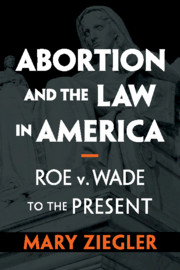Book contents
- Abortion and the Law in America
- Abortion and the Law in America
- Copyright page
- Dedication
- Contents
- Acknowledgments
- Timeline
- Abbreviations
- Introduction
- 1 Roe v. Wade and the Rise of Rights Arguments
- 2 The Hyde Amendment and Its Aftermath
- 3 Launching a Quest to Reverse Roe
- 4 Planned Parenthood v. Casey, the Family, and Equal Citizenship
- 5 Contesting the Relationship between Abortion and Health Care
- 6 Partial-Birth Abortion and Who Decides the Costs and Benefits
- 7 Polarization, Religious Liberty, and the War on Women
- Conclusion
- Notes
- Index
3 - Launching a Quest to Reverse Roe
Published online by Cambridge University Press: 28 February 2020
- Abortion and the Law in America
- Abortion and the Law in America
- Copyright page
- Dedication
- Contents
- Acknowledgments
- Timeline
- Abbreviations
- Introduction
- 1 Roe v. Wade and the Rise of Rights Arguments
- 2 The Hyde Amendment and Its Aftermath
- 3 Launching a Quest to Reverse Roe
- 4 Planned Parenthood v. Casey, the Family, and Equal Citizenship
- 5 Contesting the Relationship between Abortion and Health Care
- 6 Partial-Birth Abortion and Who Decides the Costs and Benefits
- 7 Polarization, Religious Liberty, and the War on Women
- Conclusion
- Notes
- Index
Summary
Exploring the period between 1980 and 1986, Chapter 3 studies how groups like NRLC and AUL refocused on overturning Roe. After 1978, when Akron, Ohio, passed a model law, NRLC and AUL lawyers contended that because abortion sometimes harmed women, incremental restrictions should be unconstitutional only if they unduly burdened women rather than helped them. The Supreme Court rejected abortion foes’ arguments in City of Akron v. Akron Center for Reproductive Health (1983), but writing in dissent, Justice Sandra Day O’Connor adopted a version of the undue burden standard that pro-lifers championed. O’Connor’s dissent solidified mainstream pro-life groups’ commitment to a new strategy. Rather than prioritizing a constitutional amendment, abortion foes would gradually chip away at Roe, narrowing its protections and setting the stage for its overruling. By aligning with the GOP, pro-lifers would shape who sat on the Supreme Court. And in defending access restrictions, abortion foes would highlight their benefits – and what they saw as the costs of abortion.
Keywords
- Type
- Chapter
- Information
- Abortion and the Law in AmericaRoe v. Wade to the Present, pp. 58 - 87Publisher: Cambridge University PressPrint publication year: 2020



